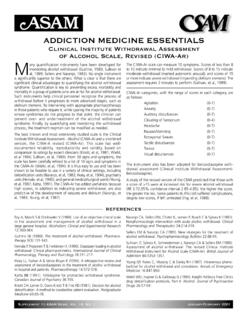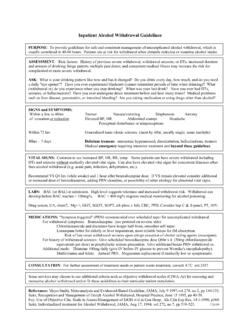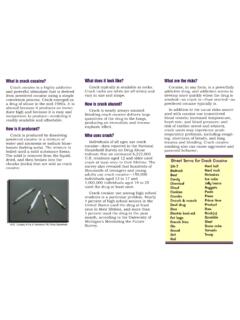Transcription of Cocaine Abuse and Addiction Research Report
1 What is Cocaine ? Cocaine is a powerfully addic-tive stimulant that directlyaffects the brain. Cocainehas been labeled the drug of the1980s and 90s, because of itsextensive popularity and use dur-ing this period. However, cocaineis not a new drug. In fact, it isone of the oldest known pure chemical, cocainehydrochloride, has been anabused substance for more than100 years, and coca leaves, thesource of Cocaine , have beeningested for thousands of Cocaine was first extract-ed from the leaf of theErythroxylon coca bush, whichgrows primarily in Peru andBolivia, in the mid-19th the early 1900s, it became themain stimulant drug used in mostof the tonics/elixirs that weredeveloped to treat a wide varietyof illnesses. Today, Cocaine is aSchedule II drug, meaning that ithas high potential for Abuse , butcan be administered by a doctorfor legitimate medical uses, suchas a local anesthetic for some eye,ear, and throat surgeries.
2 There are basically two chemical forms of Cocaine : the hydrochloride salt and the freebase. The hydrochloridesalt, or powdered form ofcocaine, dissolves in water and,when abused, can be taken intra-venously (by vein) or intranasally(in the nose). Freebase refers to acompound thathas not been neu-tralized by an acidto make thehydrochloridesalt. The freebaseform of Cocaine isgenerally sold onthe street as afine, white, crys-talline powder,COCAINEA buse and AddictionCocaine Abuse and addictioncontinues to be a problem thatplagues our nation. In 1997, forexample, an estimated millionAmericans age 12 and older werechronic Cocaine users. Although thisis an improvement over the 1985estimate of million users, we stillhave a substantial distance to go inreducing the use of this addictivestimulant. Science is helping. Forexample, we now know more aboutwhere and how Cocaine acts in thebrain, including how the drug pro-duces its pleasurable effects and whyit is so addictive.
3 Through the use of sophisticatedtechnology, scientists can actually seethe dynamic changes that occur inthe brain as an individual takes thedrug. They can observe the differentbrain changes that occur as a personexperiences the rush, the high, and, finally, the craving of can also identify parts of thebrain that become active when acocaine addict sees or hears environ-mental stimuli that trigger the crav-ing for Cocaine . Because these typesof studies pinpoint specific brainregions, they are critical to identify-ing targets for developing medica-tions to treat Cocaine Addiction . One of NIDA s most importantgoals is to translate what scientistslearn from Research , in order to helpthe public better understand drugabuse and Addiction , and to developmore effective strategies for theirprevention and treatment. We hopethat this compilation of scientificinformation on Cocaine will help toinform readers about the harmfuleffects of Cocaine Abuse , and that itwill assist in prevention and treat-ment I.
4 Leshner, Institute on Drug Abusefrom the Department of Health and Human Services National Institutes of Healthknown as coke, C, snow, flake, or blow. Street dealersgenerally dilute it with such inertsubstances as cornstarch, talcumpowder, and/or sugar, or withsuch active drugs as procaine (achemically-related local anesthet-ic) or with such other stimulantsas amphetamines. What is crack ? crack is the street name givento the freebase form ofcocaine that has beenprocessed from the powderedcocaine hydrochloride form to asmokable substance. The term crack refers to the cracklingsound heard when the mixture issmoked. crack Cocaine isprocessed with ammonia or sodi-um bicarbonate (baking soda)and water, and heated to removethe hydrochloride. Because crack is smoked, theuser experiences a high in lessthan 10 seconds. This ratherimmediate and euphoric effect isone of the reasons that crackbecame enormously popular inthe mid 1980s.
5 Another reason isthat crack is inexpensive both toproduce and to is the scopeof Cocaine use inthe United States?In 1997, an estimated mil-lion Americans ( percent ofthose age 12 and older) werecurrent Cocaine users, accordingto the 1997 National HouseholdSurvey on Drug Abuse (NHSDA). This number has notchanged significantly since 1992,although it is a dramatic decreasefrom the 1985 peak of millioncocaine users(3 percent of thepopulation). Based upon addi-tional data sources that take intoaccount users underrepresentedin the NHSDA, the Office ofNational Drug Control Policyestimates the number of chroniccocaine users at 18 to 25 years old havea higher rate of current cocaineuse than those in any other agegroup. Overall, men have a higherrate of current Cocaine use thando women. Also, according to the1997 NHSDA, rates of currentcocaine use were percent forAfrican Americans, percentfor Hispanics, and percent forCaucasians.
6 crack Cocaine remains a seri-ous problem in the United NHSDA estimated the num-ber of current crack users to beabout 604,000 in 1997, whichdoes not reflect any significantchange since 1988. The 1998 Monitoring theFuture Survey, which annuallysurveys teen attitudes and recentdrug use, reports that lifetimeand past-year use of crackincreased among eighth gradersto its highest levels since 1991,the first year data were availablefor this grade. The percentage ofeighth graders reporting crackuse at least once in their livesincreased from percent in1997 to percent in 1998. Past-year use of crack also rose slight-ly among this group, although nochanges were found for othergrades. Data from the Drug AbuseWarning Network (DAWN)showed that Cocaine -relatedemergency room visits, afterincreasing 78 percent between1990 and 1994, remained levelbetween 1994 and 1996, with152,433 Cocaine -related episodesreported in 1996.
7 2 NIDA Research Report SERIEST rends in 30-day prevalence of Cocaine Abuse amongeighth, tenth, and twelfth graders, 1991-1998 Source: Monitoring the Future Study, University of MichiganNumber of students(Thousands)12th grade8th gradeHow is Cocaine used?The principal routes ofcocaine administration areoral, intranasal, intravenous,and inhalation. The slang termsfor these routes are, respectively, chewing, snorting, mainlin-ing, injecting, and smoking (including freebase and crackcocaine). Snorting is the processof inhaling Cocaine powderthrough the nostrils, where it isabsorbed into the bloodstreamthrough the nasal releases the drug direct-ly into the bloodstream, andheightens the intensity of itseffects. Smoking involves theinhalation of Cocaine vapor orsmoke into the lungs, whereabsorption into the bloodstreamis as rapid as by injection. Thedrug can also be rubbed ontomucous tissues.
8 Some users com-bine Cocaine powder or crackwith heroin in a speedball. Cocaine use ranges fromoccasional use to repeated orcompulsive use, with a variety ofpatterns between these is no safe way to usecocaine. Any route of administra-tion can lead to absorption oftoxic amounts of Cocaine , leadingto acute cardiovascular or cere-brovascular emergencies thatcould result in sudden Cocaine use by anyroute of administration can pro-duce Addiction and other adversehealth consequences. How does cocaineproduce its effects? Agreat amount of researchhas been devoted to under-standing the way cocaineproduces its pleasurable effects,and the reasons it is so mechanism is through itseffects on structures deep in thebrain. Scientists have discoveredregions within the brain that,when stimulated, produce feel-ings of pleasure. One neural sys-tem that appears to be mostaffected by Cocaine originates in aregion, located deep within thebrain, called the ventral tegmentalarea (VTA).
9 Nerve cells originat-ing in the VTA extend to theregion of the brain known as thenucleus accumbens, one of theNIDA Research Report SERIES 3 Cocaine in the brain In the normal communication process, dopamine is released by a neuron intothe synapse, where it can bind with dopamine receptors on neighboring neurons. Normally dopamine isthen recycled back into the transmitting neuron by a specialized protein called the dopamine Cocaine is present, it attaches to the dopamine transporter and blocks the normal recycling process,resulting in a build-up of dopamine in the synapse which contributes to the pleasurable effects bycocaineCocaineDopamine receptorsReceiving NeuronTransmittingNeuronDopaminepackaged in vesiclesbrain s key pleasure centers. Instudies using animals, for exam-ple, all types of pleasurable stim-uli, such as food, water, sex, andmany drugs of Abuse , causeincreased activity in the nucleusaccumbens.
10 Researchers have discoveredthat, when a pleasurable event isoccurring, it is accompanied by alarge increase in the amounts ofdopamine released in the nucleusaccumbens by neurons originatingin the VTA. In the normal com-munication process, dopamine isreleased by a neuron into thesynapse (the small gap betweentwo neurons), where it binds withspecialized proteins (calleddopamine receptors) on theneighboring neuron, therebysending a signal to that of Abuse are able to inter-fere with this normal communica-tion process. For example, scien-tists have discovered that cocaineblocks the removal of dopaminefrom the synapse, resulting in anaccumulation of dopamine. Thisbuildup of dopamine causes con-tinuous stimulation of receivingneurons, probably resulting in theeuphoria commonly reported bycocaine abusers. As Cocaine Abuse continues,tolerance often develops. Thismeans that higher doses and morefrequent use of Cocaine arerequired for the brain to registerthe same level of pleasure experi-enced during initial use.










